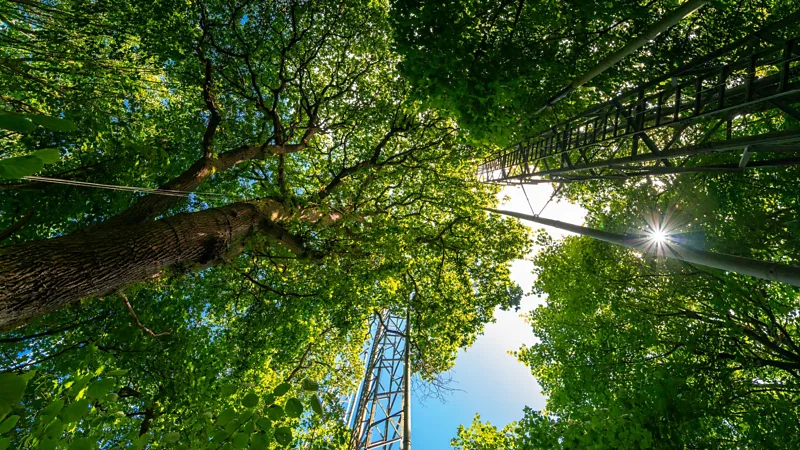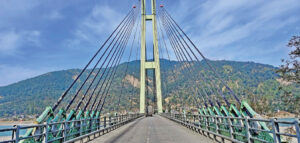
Trees might not be acting in the way we thought - this woodland fitted with channels can tell us why
The oak is the ruler of her space,” says Victimize MacKenzie as he motions towards a monster towering over us. This oak tree has stood in this exceptionally spot since long some time recently he or I strolled the Soil.Trees might not be acting in the way we thought – this woodland fitted with channels can tell us why.
It is early winter when MacKenzie, an barometrical researcher and executive of Birmingham College Established of Timberland Investigate, leads me assist into this little fix of forest here in Staffordshire, England.Trees might not be acting in the way we thought – this woodland fitted with channels can tell us why.
He treads consistently along the track, snow crunching underneath. The moo winter Sun casts long shadows, and a few feathered creatures, braving the cold, sing to each other over the timberland. Autumn’s last takes off tumble to the ground – where they arrive not on the floor, but in nets. Since this is no conventional woodland.Trees might not be acting in the way we thought – this woodland fitted with channels can tell us why
Where roots tangle over the soil, channels and wires entwine. This timberland has plumbing. Outlined oak, birch and sycamore trees stand bear to bear with towering metal outlines supporting drainpipes, which reach up to the exceptionally tops of the trees.
MacKenzie and his colleagues have sent this calm timberland fair exterior Birmingham into the future – in a way of talking. They have pumped carbon dioxide (CO2) around the develop oak trees here in arrange to recreate the climate that is anticipated to swathe planet Soil by the year 2050.
This little lush region, near to an urban city, is not the as it were one getting a impact of the future with misleadingly hoisted levels of CO2. Analysts over the globe, from Australia to the Amazon rainforest, are testing on timberlands in a offered to superior get it the part trees play in keeping the Soil cool. Their discoveries seem change our understanding of how the woodlands of the future will react to climate alter.
MacKenzie and his colleagues have been running their test for seven a long time to date, and the comes about have astounded them. Opposite to a few past examinations, their think about recommends that trees can really retain more carbon as they age. It’s a finding that highlights the colossal significance of develop, calm woodlands in terms of climate regulation.Trees might not be acting in the way we thought – this woodland fitted with channels can tell us why.
What’s more, for the to begin with time, MacKenzie and his individual forest-watchers have moreover appeared that minuscule life forms living on these trees capture methane, another nursery gas hurtful to the climate. “[We] found the trees are giving another unforeseen benefit for us,” says MacKenzie. “The canopy has organisms, and these organisms eat the methane. There are parts of reasons to sustain forests.Earth’s characteristic nursery impact – whereby gasses such as CO2 and methane retain the Sun’s warm as it transmits back from the Earth’s surface, catching it in the air – is imperative for life as we know it. It makes a difference to keep the normal worldwide surface temperature comfortably over freezing.
Carbon sinks, in the mean time – such as timberlands, seas and soils – retain CO2 from the climate, avoiding the Soil from overheating due to this nursery impact. Our climate has existed this way for centuries, in a sensitive state of balance.
Vast swathes of the world are approximately to alter, or are without a doubt changing – Ransack MacKenzie
However, with rising nursery gas outflows from human exercises, the sum of those gasses retained by nature has expanded, as well. It has made plants develop speedier, a prepare known as CO2 preparation. Characteristic carbon sinks right now retain generally half of all human-produced carbon outflows, concurring to gauges. But specialists caution we may be on the skirt of tipping the adjust – with both sea and arrive sinks appearing signs of battling to keep up.
In reality, extraordinary warm and dry spell, timberland fires and deforestation, arrive utilize alter, softening permafrost and warming seas may all lead to carbon sinks such as timberlands changing into carbon sources – meaning they radiate more CO2 than they absorb.”Climate alter is happening speedier, to the best of our understanding, than the common flexibility of each biological system,” says MacKenzie. “Lowlands are turning into inadequate timberlands, inferior woodlands are turning into lakes. It’s a framework move. And timberlands are defenseless the same way as each biological system is.”
Tree species themselves are moreover progressively at hazard. Agreeing to the 2024 overhaul of the Universal Union for Preservation of Nature’s Ruddy List, over one-third of the world’s trees are presently in peril of termination due to worldwide warming, deforestation and obtrusive species.
Related,








1 thought on “Trees might not be acting in the way we thought – this woodland fitted with channels can tell us why”